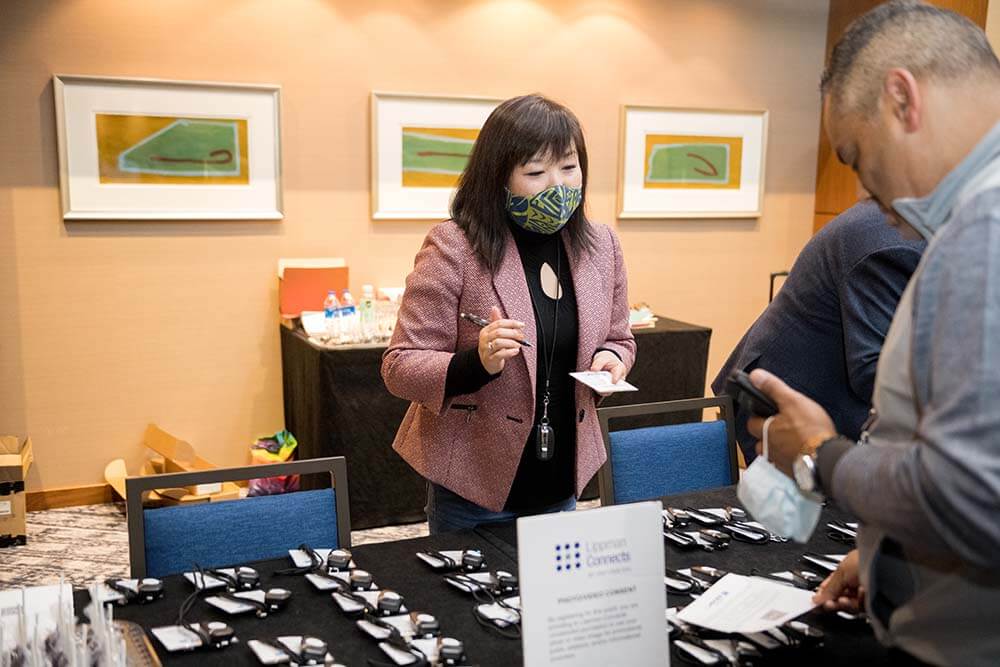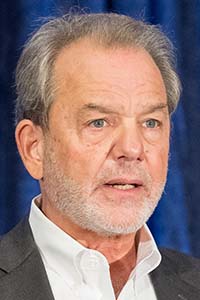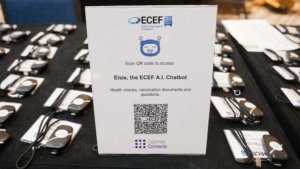Automated Contact Tracing: The Next Big Thing for Events?
ECEF attendees tried out a contact-tracing wearable that helps event organizers measure and communicate COVID-19 exposure risk to participants.
Author: Barbara Palmer

An attendee at the Exhibition & Convention Executives Forum picks up his badge and contact-tracing device. Participants wore the lanyards with wireless-enabled fobs that kept a record of where they were in relation to others and for how long. (Chris Ferenzi Photography)
When the Exhibition & Convention Executives Forum (ECEF) convened in early November, its organizer Sam Lippman, president of Lippman Connects, changed almost everything about the 20-year-old event, including making it hybrid, with a digital audience, for the first time.

Sam Lippman
For the in-person part of the event, held Nov. 3 at the Hyatt Regency Hotel in Arlington, Virginia, Lippman included a list of safety measures that are becoming increasingly standard for events in response to the pandemic. In addition to a floorplan that provided space for social distancing for all activities, the event required that participants be fully vaccinated or supply a negative COVID-19 test taken with 72 hours of the event, and that they comply with mask mandates and complete health checks via an app.
Lippman also added a high-tech safety feature — wearable contact-tracing technology called Check-In, provided by the global consulting firm PwC. Attendees wore lanyards with wireless-enabled fobs that picked up signals from other participants’ fobs, creating a record of where attendees were in relation to others and for how long. If anyone were to notify Lippman’s staff that they had received a positive COVID-19 test after the event, ECEF could use the data collected by Check-In to notify attendees who had been exposed and supply information about their level of risk, based on how much time and how close they had been to the person or persons reporting infection.
The technology’s ability to quantify individual risk helps resolve a dilemma that event organizers face in deciding how to handle post-event notifications of positive COVID-19 tests, said Laura Skladzinski, director for Connected Solutions for PwC Digital, who worked with Lippman to furnish Check-In to ECEF participants. It’s possible that some organizers may choose not to follow up at all with participants following an event, even if it turns out that one or more attendees more tested positive for COVID-19, she said. On the other hand, event organizers may decide to alert all meeting participants that they are at risk, even if only one person at a 5,000-person meeting reported a positive test — information that won’t help individuals calculate their own levels of risk, she said.
Check-In’s proprietary algorithm calculates risk based on the proximity of fobs to one another over time. By using the fobs to measure how close participants were to one another and for how long, Check-In can tell participants if their exposure risk is low, medium, or high without disclosing personal information, including the locations of individual participants, Skladzinski said. For example, Check-In “can’t tell you,” she said, “‘The infected person was in the bathroom at this time and then in the main speaker lounge at this time.’ We’re giving you the information that you need in order to feel comfortable” about your risk of exposure, she said, “without compromising any of the privacy side of things.”
Lippman, who for a decade was a vice president at the Consumer Electronics Show (CES), heard about Check-In from a former colleague at CES, where the technology will be used at some CES events in January. “What I try to do at ECEF,” he said, “is introduce everyone to ideas and technologies that then can help them at their own events.” Some attendees joked that they thought the fob would report how many trips they took to the bar at the event’s reception (which Check-In can’t actually report), but 100 percent of the attendees used the Check-In technology, Lippman said. Event staff and hotel staff who were in close contact with event participants also wore the fobs.
The technology used in Check-In was developed in 2020 by PwC to help the consulting firm’s thousands of global employees safely and comfortably go back to work, Skladzinski said. Then the company’s corporate clients began to ask about using it as they considered their back-to-work plans, she said. “They’re finding that people are coming in and then some people are just nervous,” she said. “You know, when you’re sitting around a conference table with people and somebody starts coughing, you start to think — ‘Oh, are you sick? Or do you just’ — and I’ve had this happen to me — ‘have a piece of black pepper in your throat?’”

The wearable contact-tracing technology called Check-In was provided by the global consulting firm PwC. (Chris Ferenzi Photography)
Check-In became available this year for events, Skladzinski said, after she realized that one of the biggest use cases for the technology could be events that gather large groups of strangers together. Earlier this year, the technology was used by a client that Skladzinski can’t name but whose event involved a red carpet and a major awards show.
“COVID has made a lot of people a little bit nervous about meeting strangers,” she said. “There’s the question of, ‘Is this person vaccinated or isn’t this person vaccinated?’” In addition to tracking exposure, she said, fobs serve as a physical reminder that everyone is following the rules.
Before ECEF, Lippman’s team used multiple communications channels to make sure people understood how the contact-tracing technology worked, including through emails and in webinars, Lippman said. “We wanted to to explain and alert people that when they arrived on site, they would be given this contact-tracing device,” he said, “because you don’t want to, obviously, surprise people. And if there’s something new, you really want to let them know, in multiple ways and multiple times, that they will be asked to cooperate in a new way.”
Lippman said he would use the wearables again “if we are still in a COVID environment.” In survey results following the event, feedback from attendees included comments praising the safety measures taken at ECEF. “They felt safe and that’s obviously why we do all this,” he said.
And, two weeks after the event, Lippman reported that he had not had to put Check-In’s contact-tracing features to the test. “Luckily, we didn’t have to use it,” he said. None of the approximately 200 participants or staff at the event had contacted him to say the that they had contracted any communicable diseases.
Barbara Palmer is deputy editor at Convene.

